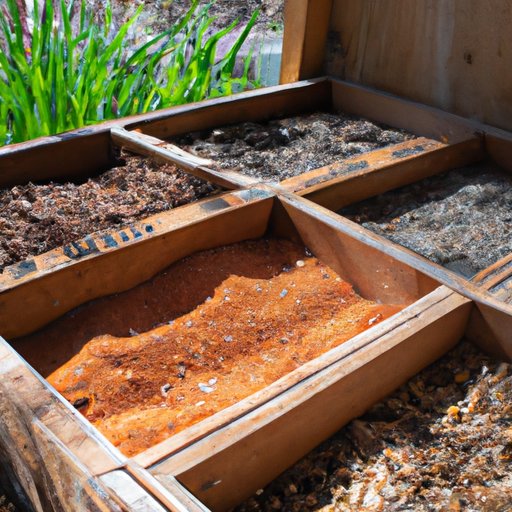Companion Gardening with Peas: What Grows Well with Peas?
Peas are one of the quintessential garden vegetables, and they can add a delicious touch to any dish. They’re also quite easy to grow and are a great crop for beginners. With a little preparation and care, anyone can have a productive pea garden. But what exactly grows well with peas? In this article, we will explore the best companion plants for peas, the importance of soil preparation, how to maximize pea yields through vertical gardening, and seasonal planting and crop rotation techniques to ensure a healthy garden.
Companion Planting
Companion planting is planting different crops together to benefit each other, whether by attracting beneficial bugs or by providing nutrients. Peas are a great candidate for companion planting as they are nitrogen-fixing legumes which provide better soil conditions for its neighboring plants. The best plant companions for peas are carrots, radishes, and lettuce. Carrots and radishes help keep the soil loose, which promotes better root growth in peas. Meanwhile, lettuce acts as a living mulch, retaining moisture in the soil and providing shade from the harsh sun while also reducing weed growth.
When planting peas with their companions, it is often best to plant the entire crop together, rather than interplanting them. Peas grow tall and can shade their neighboring plants, so it is important to consider their height when planting. Ensure that each companion has adequate space to grow and develop.
Soil Preparation
Peas grow best in well-drained, fertile soil. Soil preparation is key to creating the right environment that they need to thrive. The ideal soil pH is between 6.0 and 7.5. Work the soil deeply, incorporating organic matter and ensuring that there are no rocks. This preparation helps the pea plant create a strong root system and retain the necessary moisture and nutrients.
Since peas are nitrogen fixers, they can grow efficiently and produce more if the soil is rich in nitrogen. Whether in the form of compost or manure, adding nitrogen-rich material is essential to achieving an optimal yield. When planting in spring, apply a balanced fertilizer formulated for vegetable gardens 2 to 3 weeks before planting.
Vertical Gardening
Vertical gardening is an excellent way to increase yields and save garden space with peas. Trellising can take many different forms such as A-frames, lattices, teepees, or wires, allowing the gardener to choose the method that best suits their space and preferences. Trellising or training the pea plant help minimize soil contact, reduce pest infestation, improve air circulation, and light exposure.
When trellising pea plants, it is important to consider their height. While peas don’t have tendrils to cling and wrap around vertical structures, they are naturally inclined to grow upwards. So it is best to provide them with the support they need to enable growth. Staking the plants may also be necessary when they grow too heavy and can topple over.
Seasonal Planting
Peas are cool-weather plants that are best planted in the early spring or late summer through the fall. In spring, plant peas as soon as the soil can be worked in. A fall planting can result in a yield as long as six weeks earlier in the season than a spring planting. With good plant companions such as beets, spinach, and kale, one can also enjoy a succession planting from early spring to late fall.
When planting a seasonal garden with peas, it is essential to consider the seasonal transitions and temperature fluctuations. Gardeners must adjust the timing of planting based on the temperature requirements and weather patterns in their region. It is also wise to plant in areas that provide adequate sunlight to ensure optimal photosynthesis and growth.
Crop Rotation
Crop rotation helps manage pests and diseases while maintaining soil health. By planting different crops each year and rotating their locations in the garden, it is possible to reduce soil-borne pests and diseases and limit soil nutrient depletion. For optimal soil health, gardeners must rotate crops regularly. Peas are a part of the legume family and should be rotated with other non-legume crops, such as corn, squash, or tomatoes.
When implementing crop rotation, it is advisable to observe a three to four-year rotation cycle. Gardeners also can interplant with a beneficial cover crop which helps improve soil structure and provides additional organic matter while also suppressing weed growth and reducing the amount of artificial fertilizer and watering needed.
Conclusion
In conclusion, peas are a great addition to vegetable gardens, and they grow well with plants such as carrots, radishes, and lettuce. We have discussed the importance of soil preparation, maximizing yields using vertical gardening as well as seasonal planting, and maintaining a healthy garden with crop rotation. With proper preparation, care, and maintenance, anyone can have a healthy and productive pea garden.
So, go ahead and experiment with companion planting, soil preparation, and other methods to find the perfect combination for your pea garden.
(Note: Is this article not meeting your expectations? Do you have knowledge or insights to share? Unlock new opportunities and expand your reach by joining our authors team. Click Registration to join us and share your expertise with our readers.)
